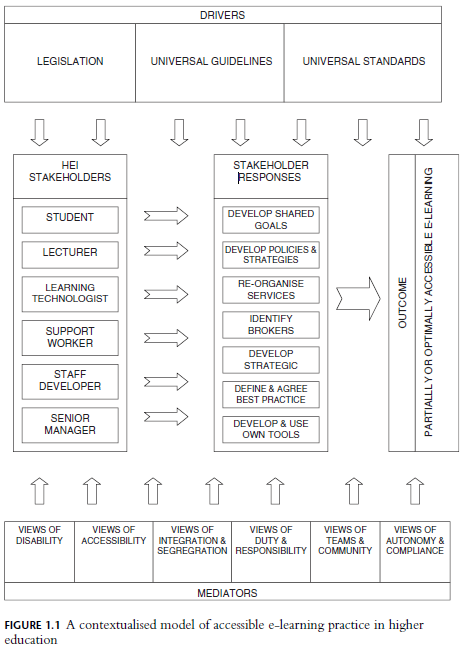Terms used in accessibility discussions
These notes are part of a series for the book.
Outline
- Introduction
- Scoping the landscape
- Higher education
- Disability
- E-learning
- Assistive technologies
- Accessibility
- Stakeholders
- Accessibility stakeholders and their practice
- Voices and silences
- Disabled students, voice and silence
- Accessibility stakeholders, voice and silence
- Accessibility mantras, voice and silence
- Political voices in the academic accessibility community
- Re-imagination
- Conclusion
Notes
This first chapter sets out definitions of terms and the reasons behind her focus or arguments made in the book.
Definitions
There is nothing unusual about how she defines the terms:
- Disability: Different from an impairment; she will use the phrase “disabled students”; she notes there are arguments that labels are stigmatizing, focus on what a person cannot do, and that there are debates about whether to say “student with a disability” or “disabled student”. This is a reference to the person-first language that is frequently used in the US; she is indicating that she will not be using person-first language in this case.
- E-learning: Any technology that enhances learning, including software, hardware, multimedia, learning objects, etc.
- Assistive technologies: These are under the e-learning umbrella for the purposes of this book, and can be further divided into seven groups as identified by JISC TechDis:
- Alternate interfaces
- Visualization tools
- Reading tools
- Recording tools
- Writing tools
- Planning tools
- Communication tools
- Note: For more detail, see Genres of assistive technologies
- Accessibility: The flexibility built into the learning environment that supports the needs of all learners, and the availability of alternative resources and activities
- Stakeholders: The students, people who teach and create learning material, the student support services, and managers
Model of accessible e-learning practice

(Seale, 2014, p. 12)
Change in focus from the first edition
She reviewed her first edition and current events that happened after its publication. She makes 3 observations about the activities from 2005 (first edition) – 2012 (second edition):
- There’s not been much improvement in accessibility.
- The voices of stakeholders are largely ignored in the studies and literature. There’s also an assumption that universal design and accessibility training will solve the problems.
- The accessibility field is stagnating.
See also
The article that identifies seven genres of assistive technologies: JISC TechDis (2007) ‘From good intenton to good practice; making the disability equality duty meaningful’, TechDis Senior Management Briefing 5. Available at https://web-beta.archive.org/web/20071012190147/http://www.techdis.ac.uk/getbriefings.
Additional contextual information about universal design can be found in the Wikipedia article about Design for All.